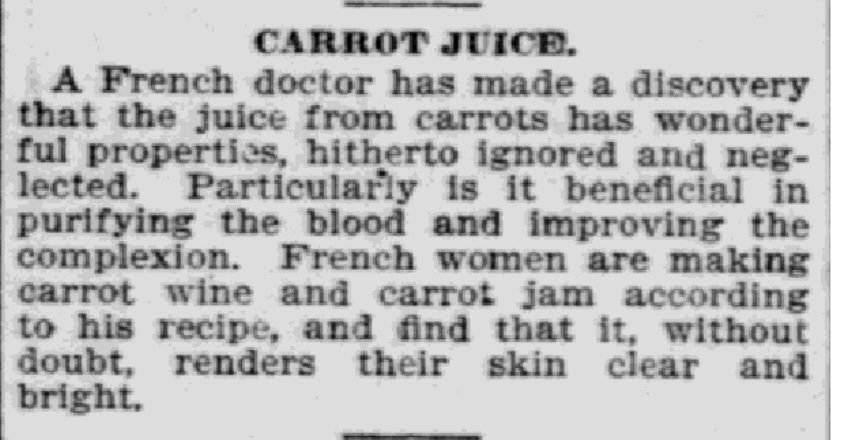Carrot Sauce
Until the 1890s American consumers did not regard the carrot as a tasty vegetable. Because livestock cherished the taste of carrots, they were widely planted. But in dishes, they tended to serve as an ingredient in a dish—chopped in a stew, diced in a soup—rather than featured as a stand-alone. Because of its second rate status at the table, it rarely featured in sauces, until the physical culture movement renovated the standing of the carrot, celebrating it as a healthful vegetable, at the very end of the 19th century.. [News blurb below, NY Irish World (March 10, 1900), 11].
With each decade the claims concerning the benefits of carrots increased, beginning with the traditional doctrine that they improved eyesight, When vitamin theory became fully elaborated in the early 20th century, the beta-carotene in the carrot was shown to be a rich source of Vitamin A and it also provided substantial amounts of Vitamin K. By the 1920s the estimation of carrots had undergone a complete revolution: they were “crunchy, tasty, and healthy.” Sanitariums and Spas began touting the benefit of carrot juice as a beverage. Heretofore its primary culinary purpose had been to supply color to butter.
Carrot sauce—usually some amalgam of cooked carrot puree, flour, and butter—became a home-prepared dressing shortly after the beginning of the 20th century. There was little of the creativity in applications of carrot sauce that home cooks manifested in devising carrot cakes. Carrot sauce was good for . . . green peas. Since pears and carrots were the mainstay vegetable dish in which carrots came to the table from 1900 to 1920, we can see that the popular culinary imagination was not exerting much energy. The second favorite employment was as sauce for baked white fish—cod or haddock [“Cod with Carrot Sauce,” Duluth News-Tribune (June 24, 1906), 4.]
The Colorado Statesman provides a classic version of carrot sauce in its July 14, 1923 issue. This is a true sauce not a dish of creamed minced carrots that has been called “carrot sauce,” as was found all too often in newspaper recipe sections.
All of the carrot sauce recipes presumed that the carrots were classic orange in color. Yet a rainbow of carrot colors was imported to the United States from Flanders, the European hotbed of carrot culture. Red, Pink, Orange, Purple, Yellow, Gold. These splendid hues were taken up by chefs early in the 21st century making technicolor purees. A trick in preserving the original carrot color is to use arrowroot as a thickener rather than flour which dulls the tint. Arrowroot makes the sauce shine true to the raw carrots’ original colors.
A word on texture. Most of the sauce recipes from the early 20th century that employed mashed carrots sought a smooth texture. A 21st century innovation is to retain small chunks of cooked carrot in the puree to amuse the mouth.







Did you mean PEAS and carrots?? Instead of pears?